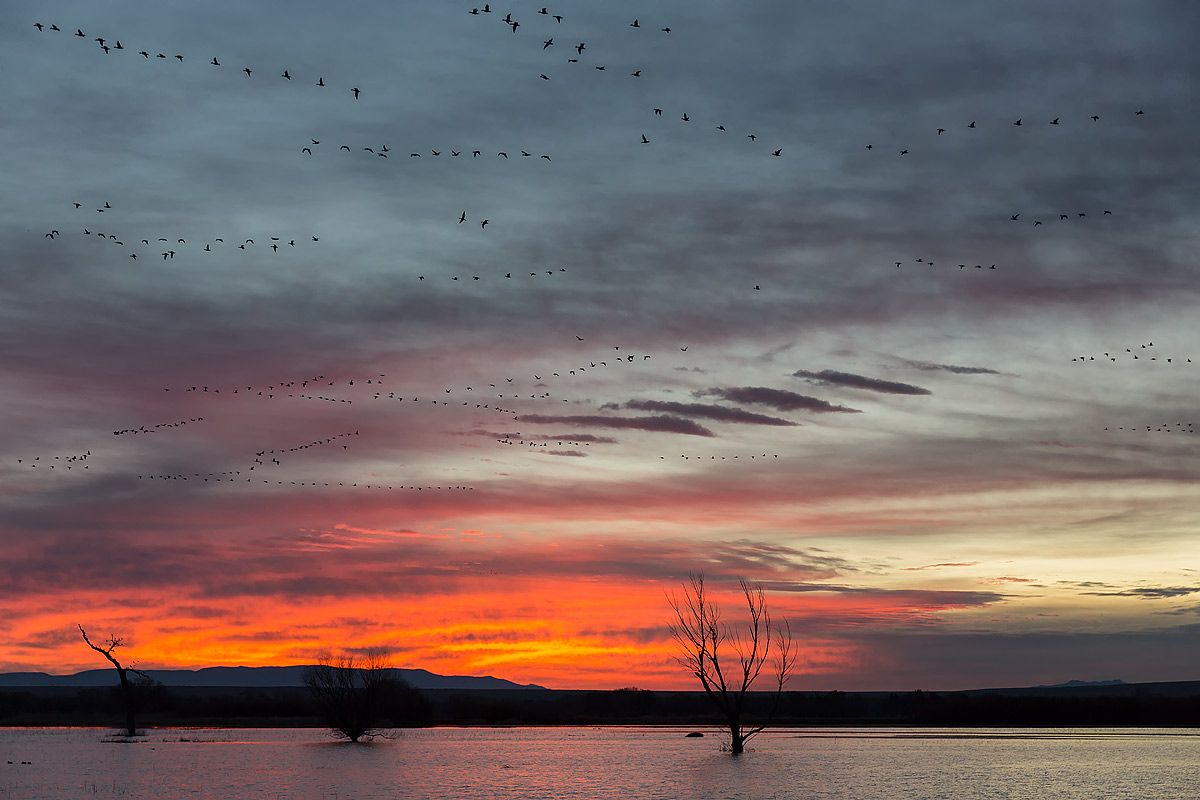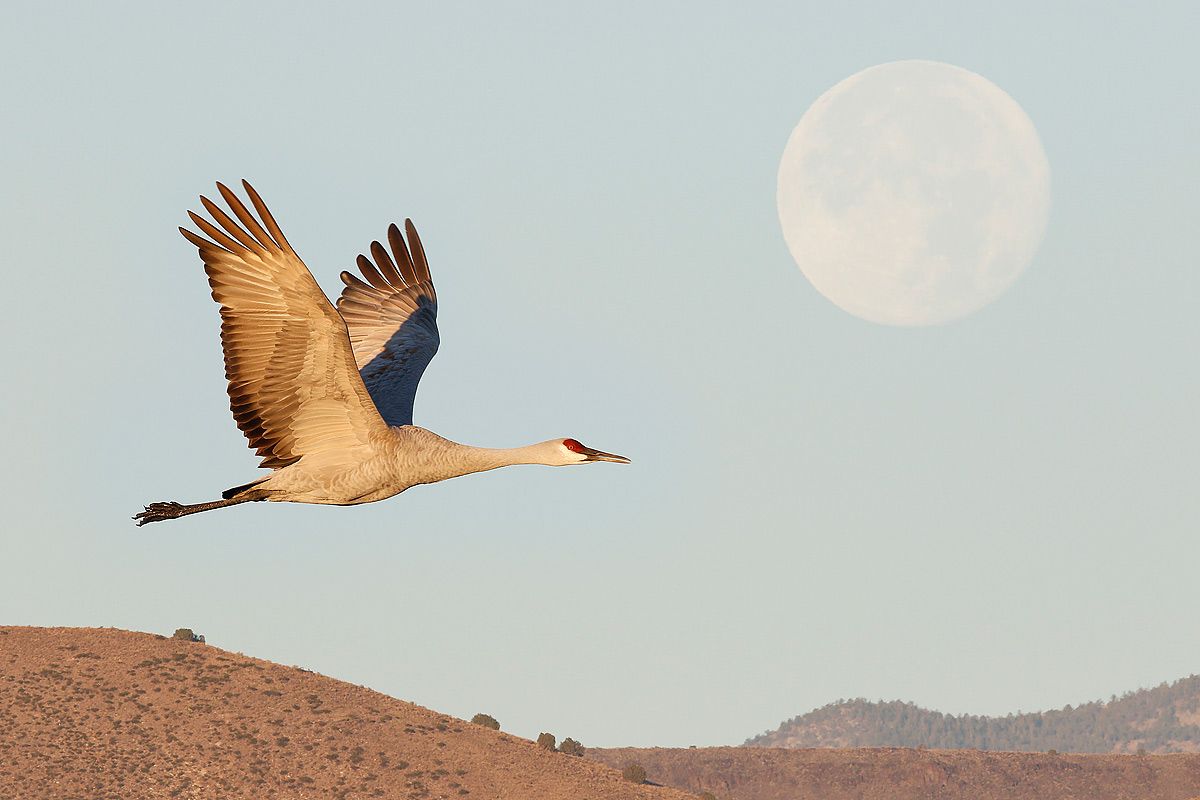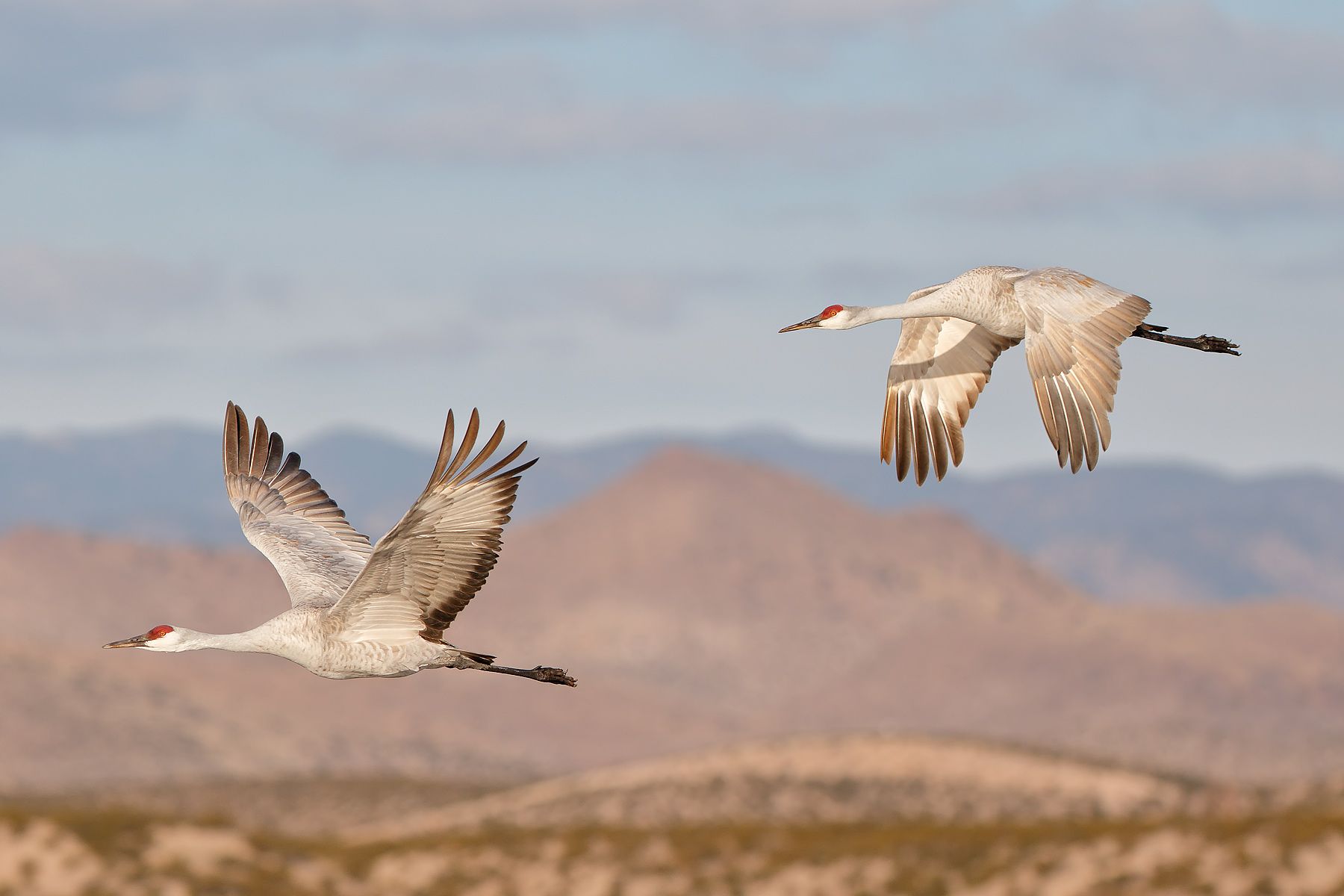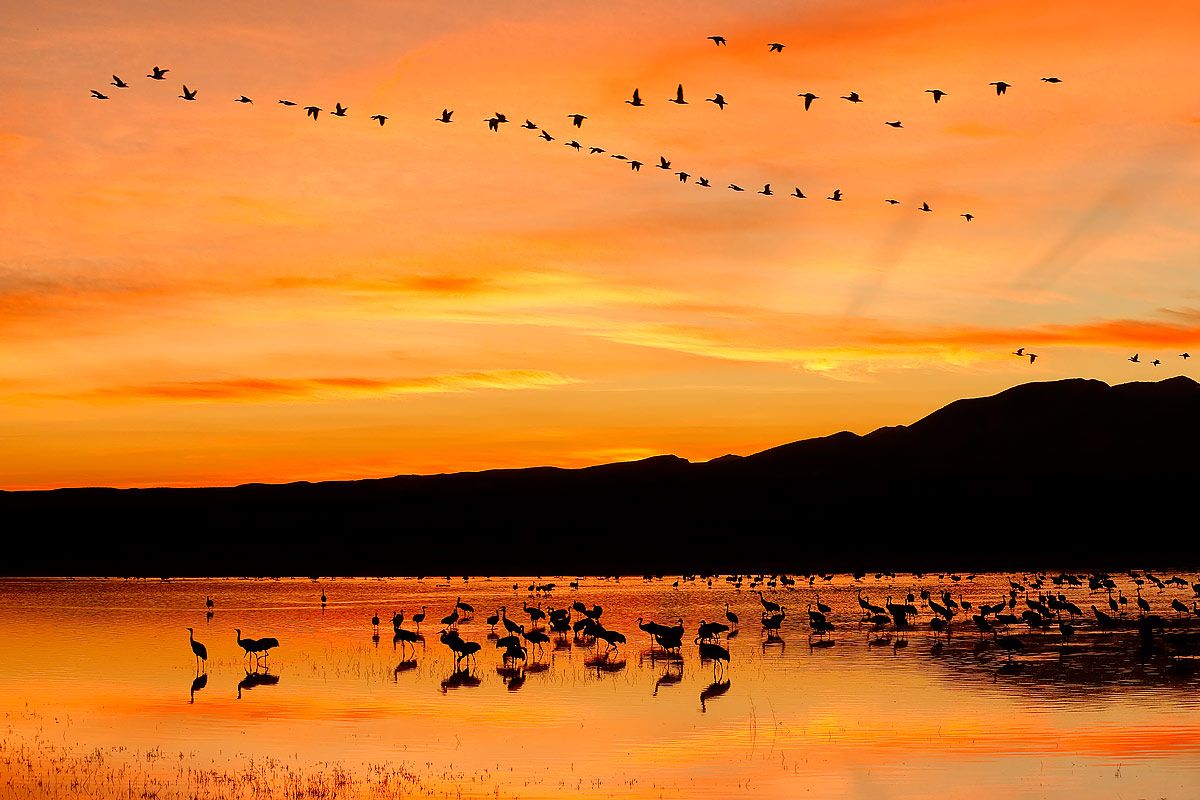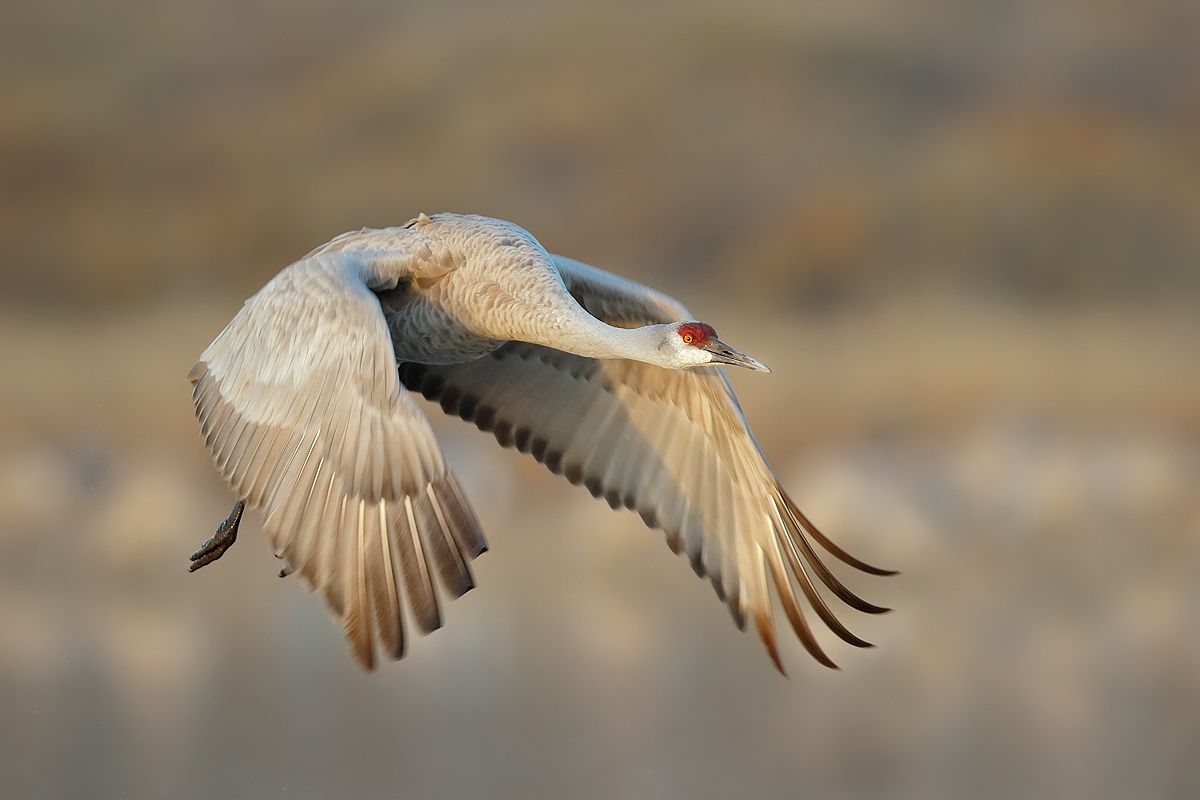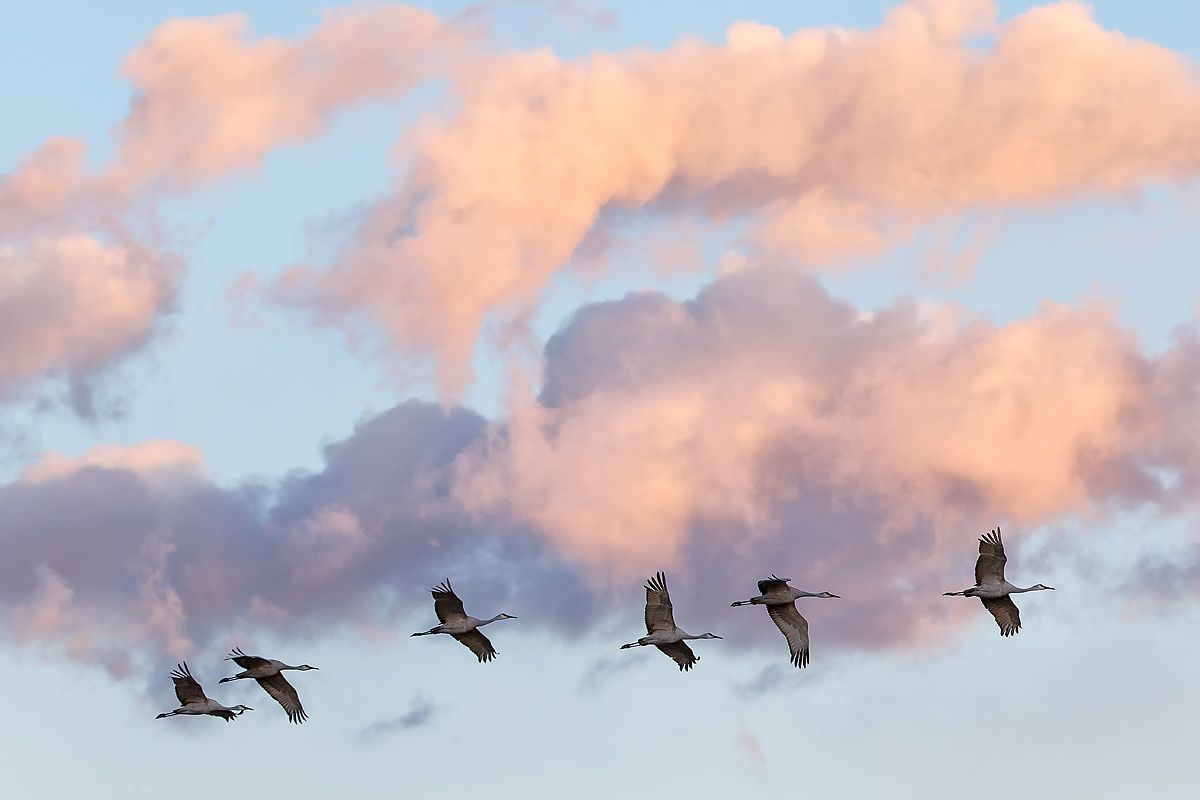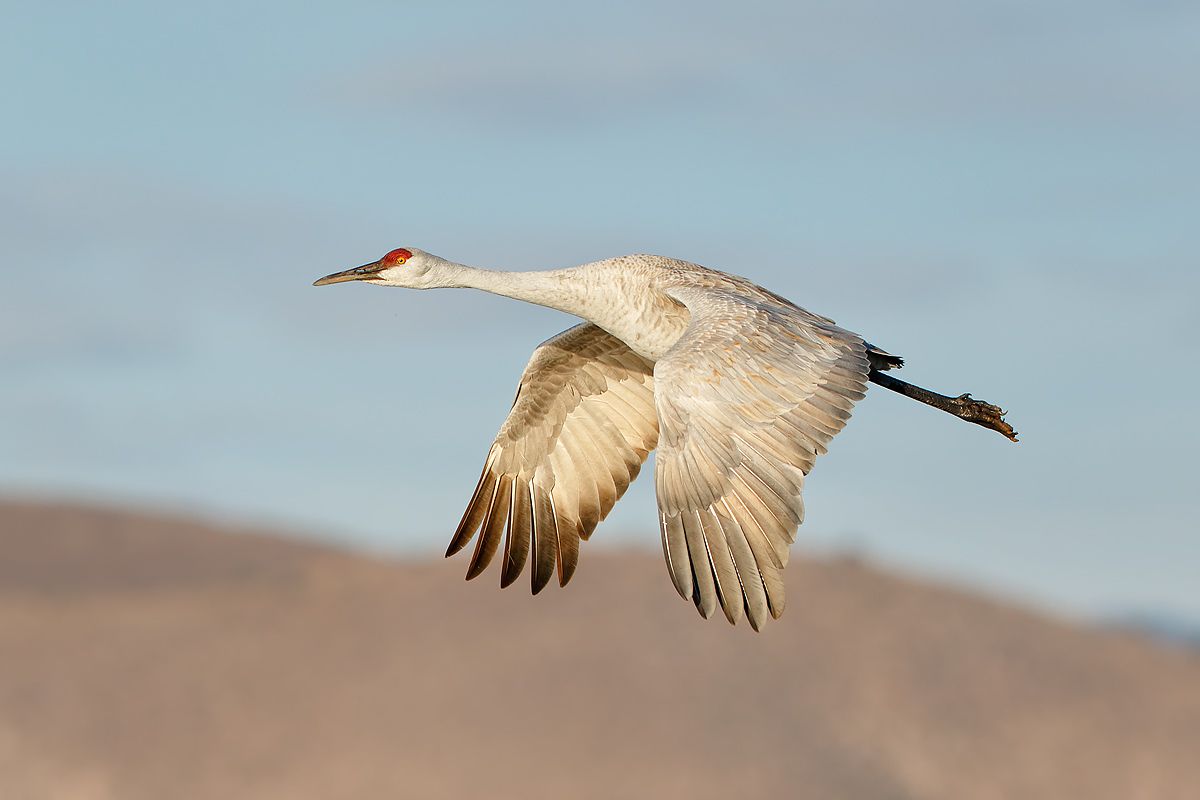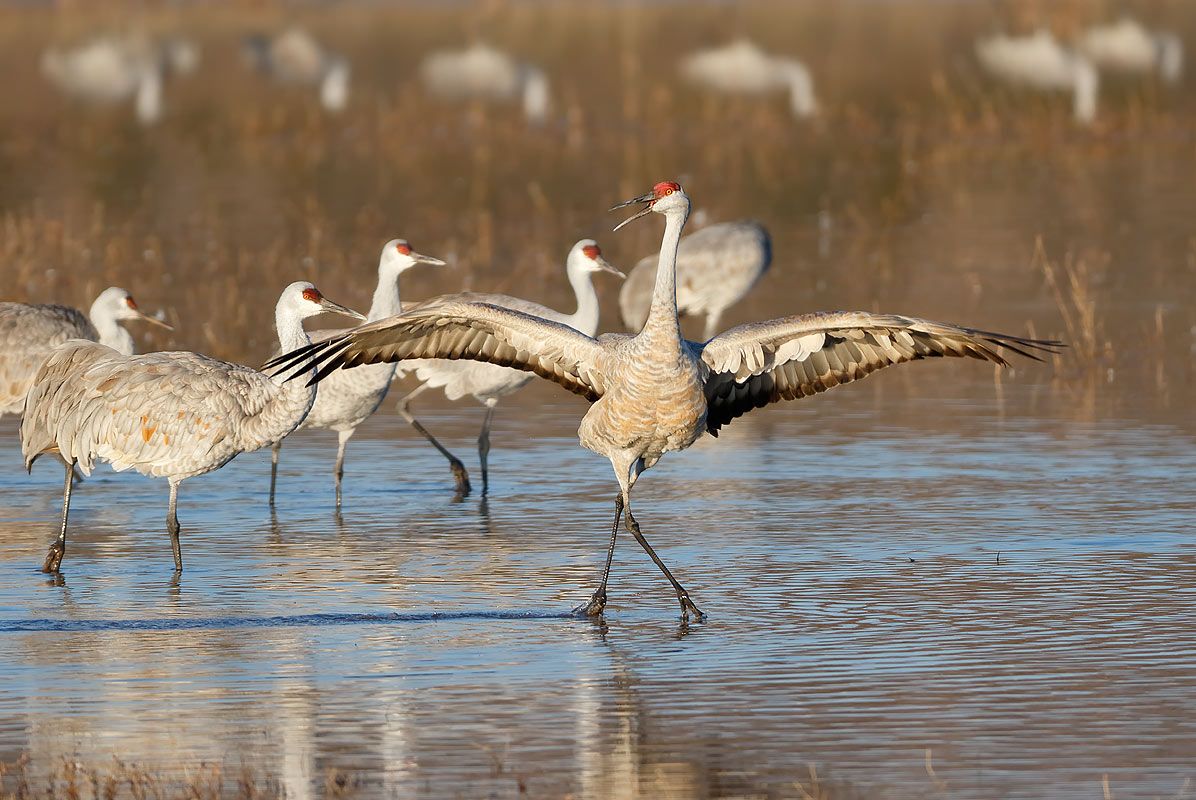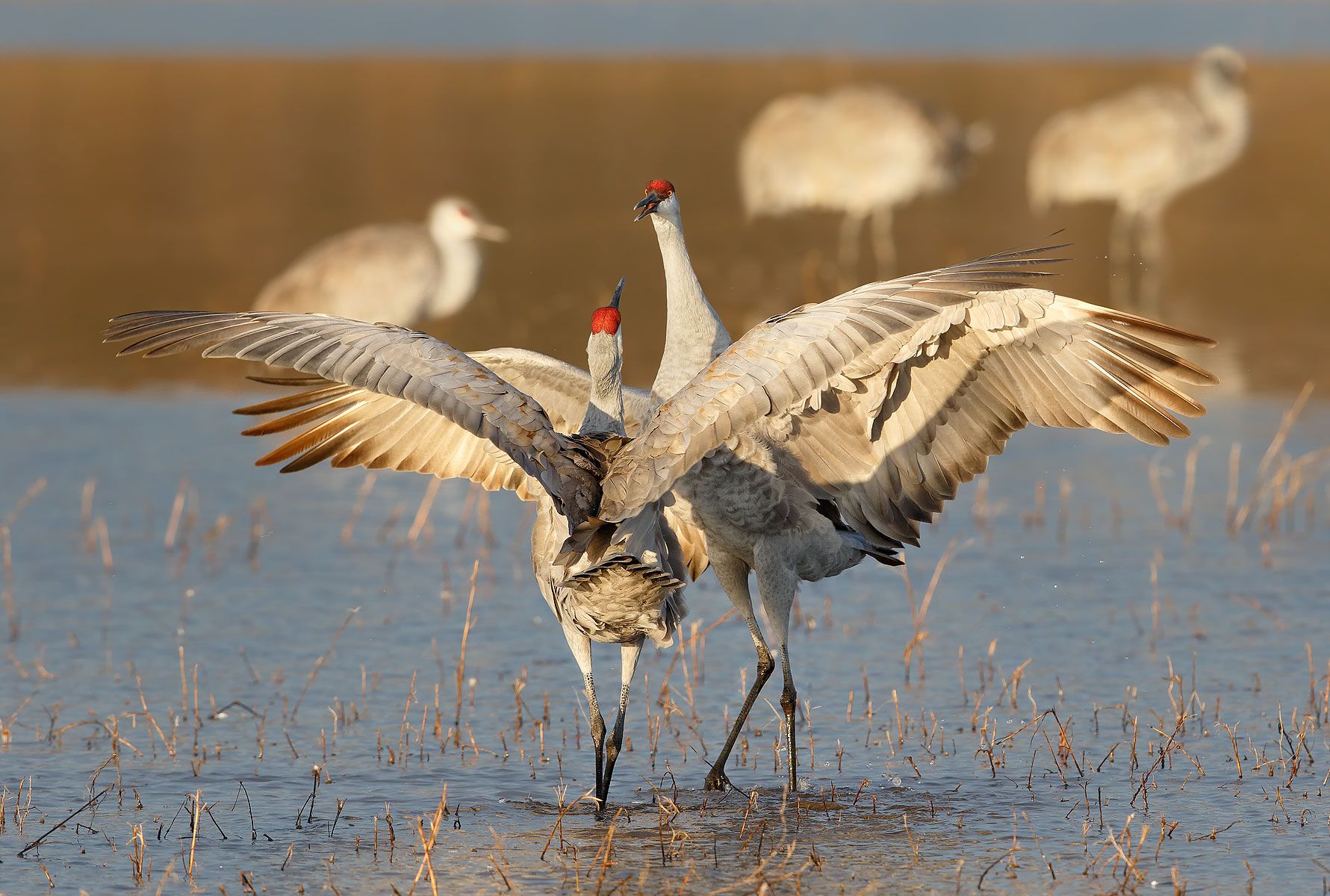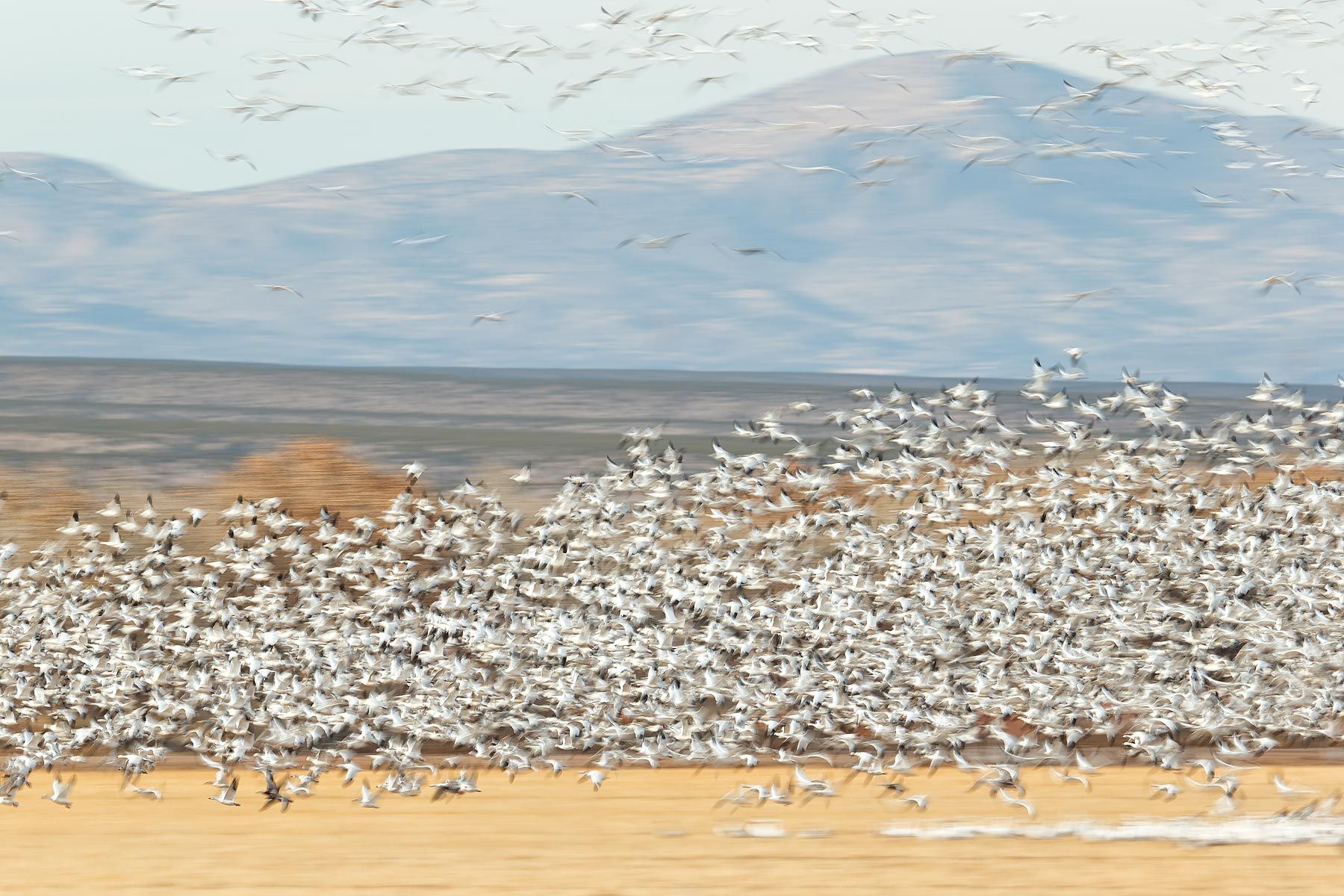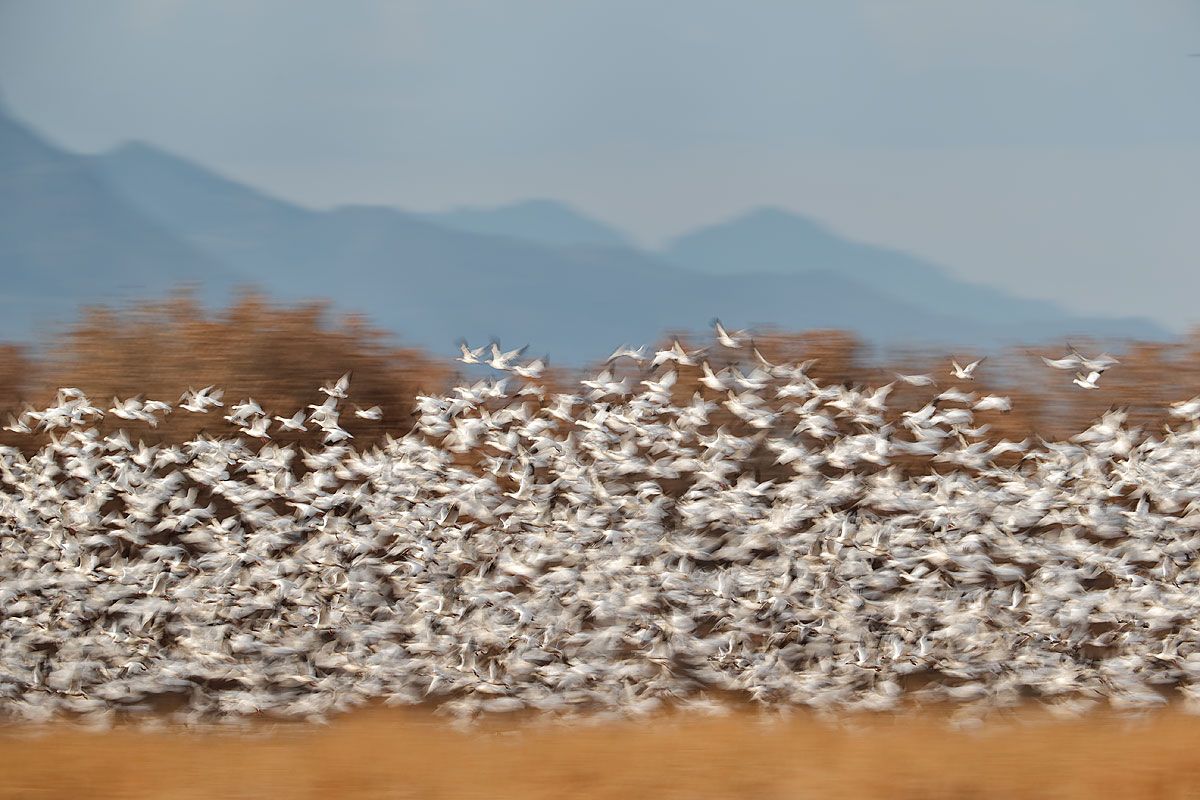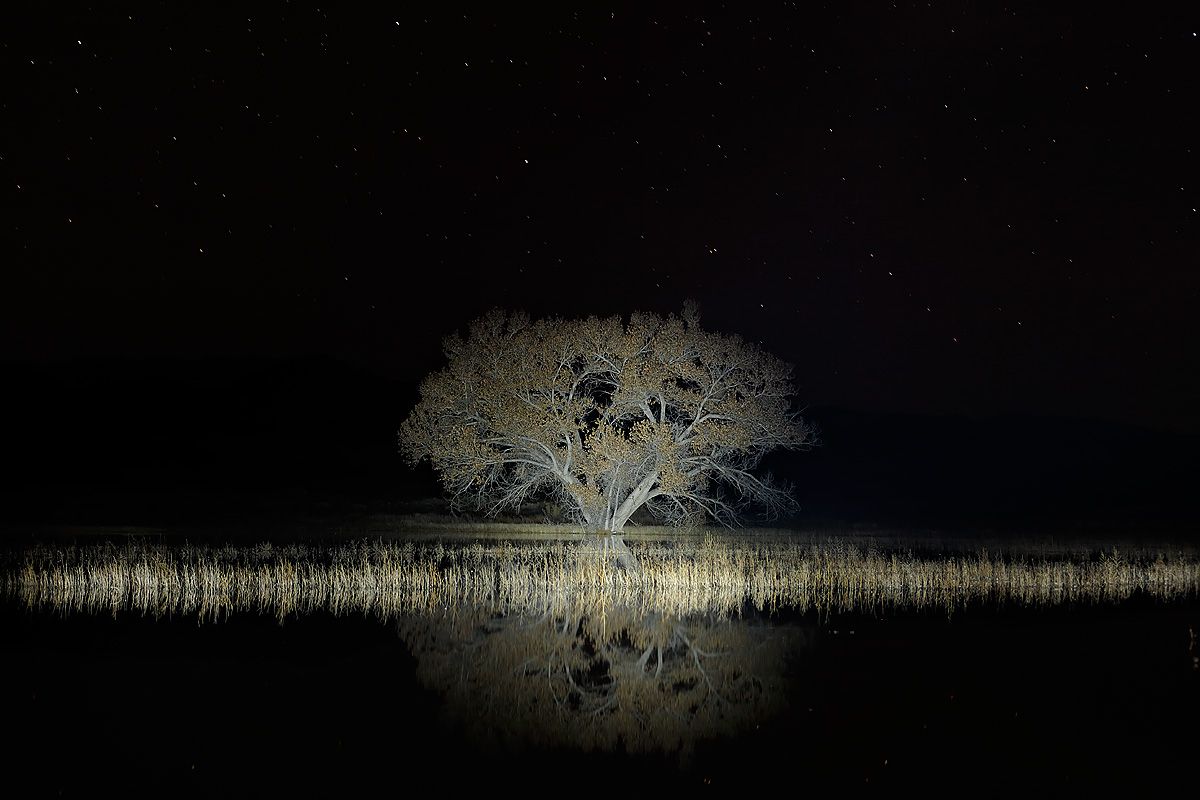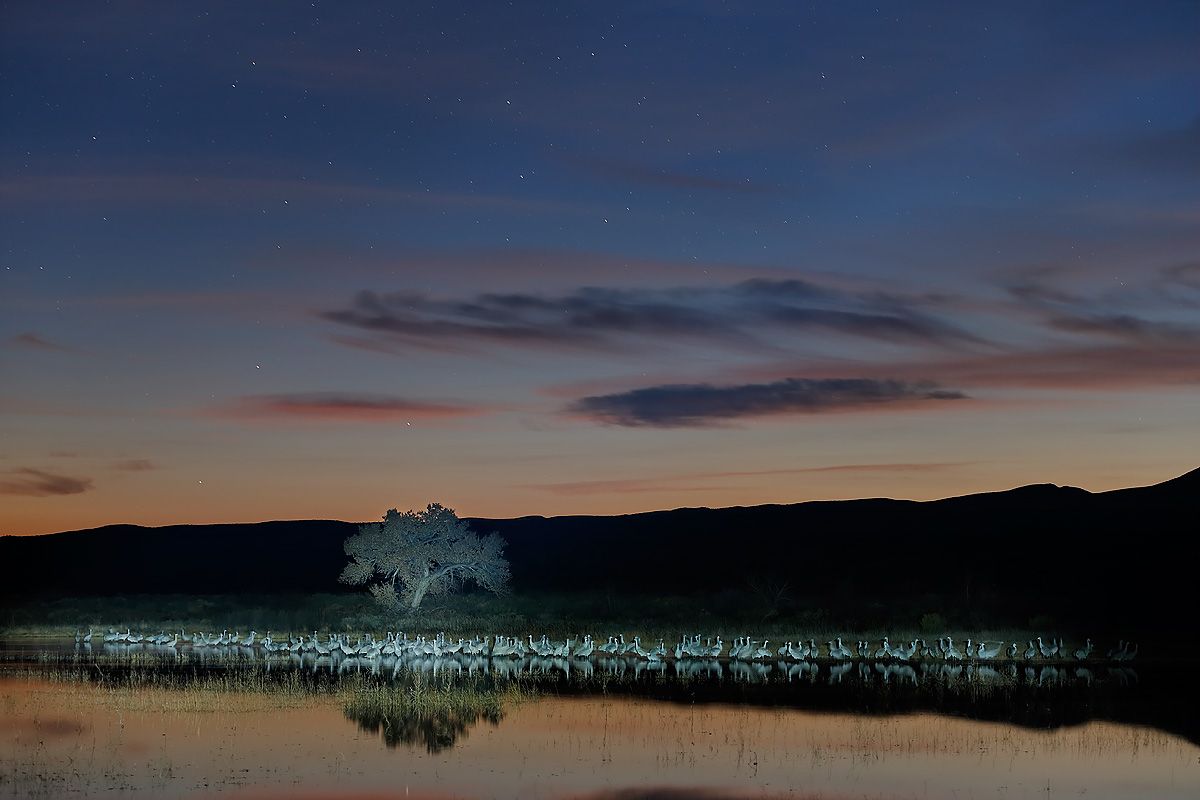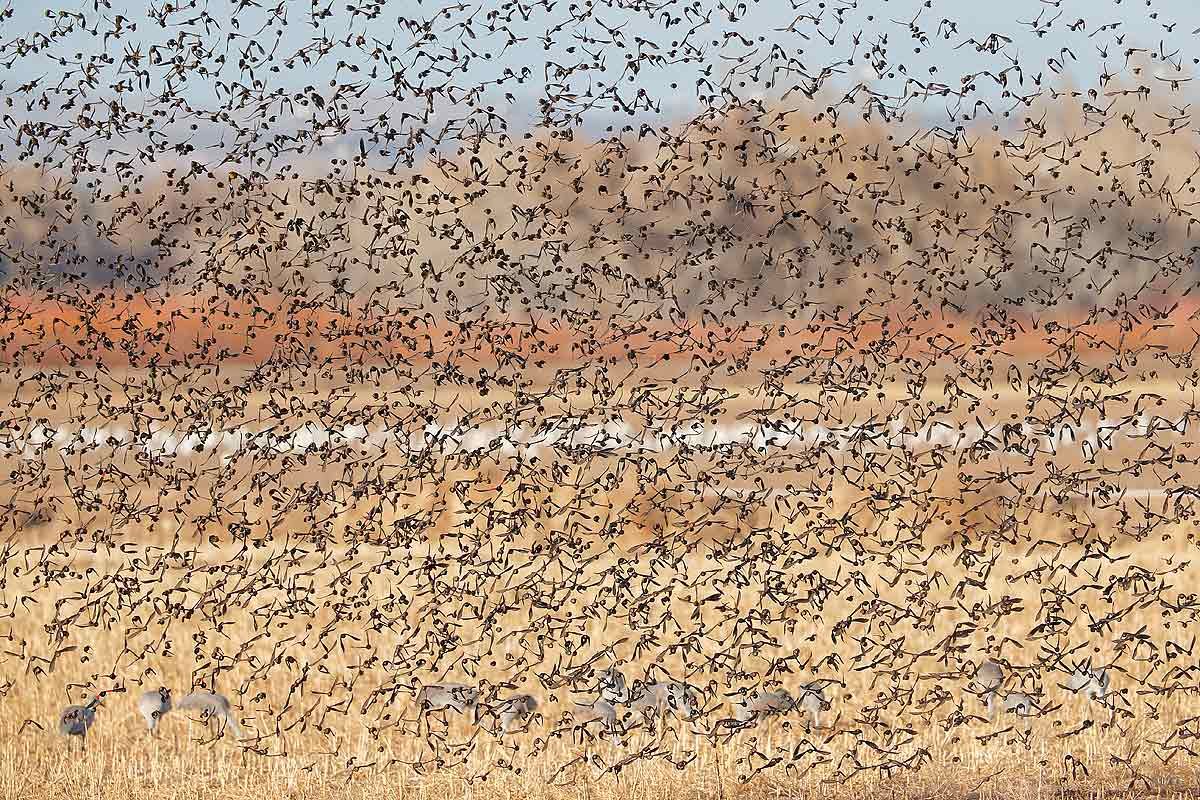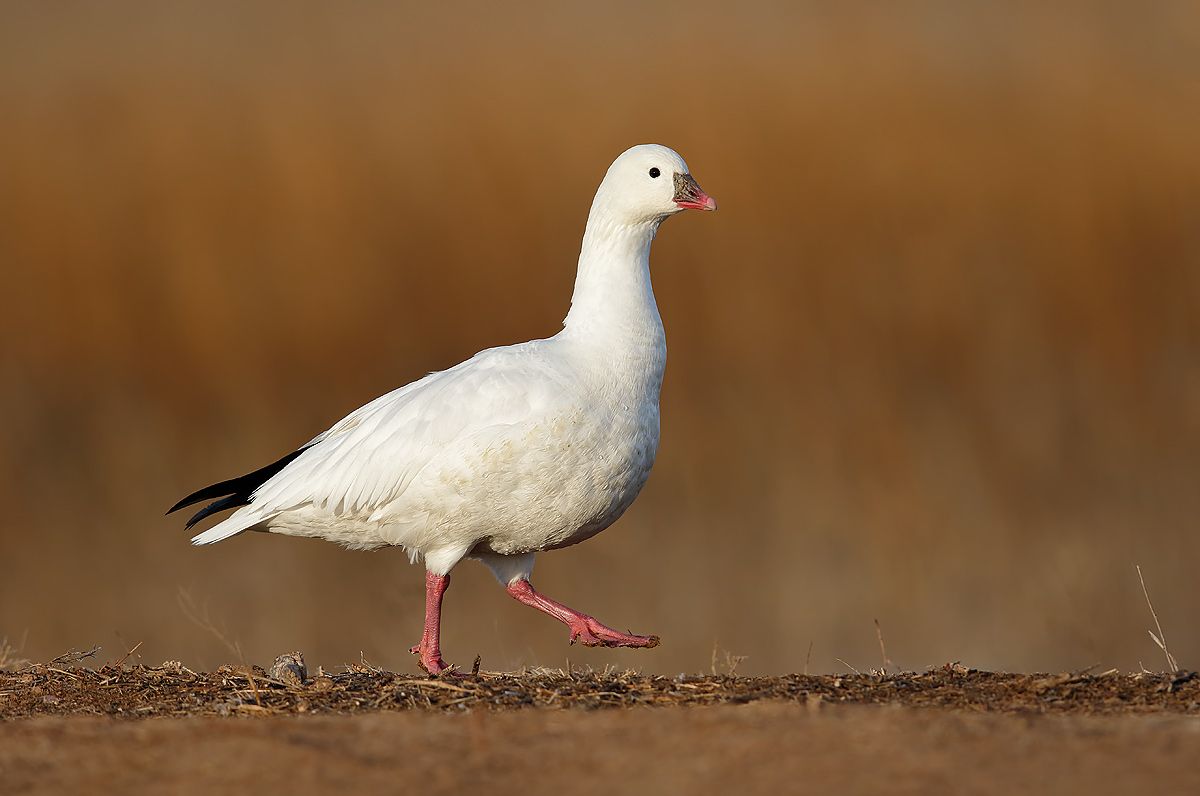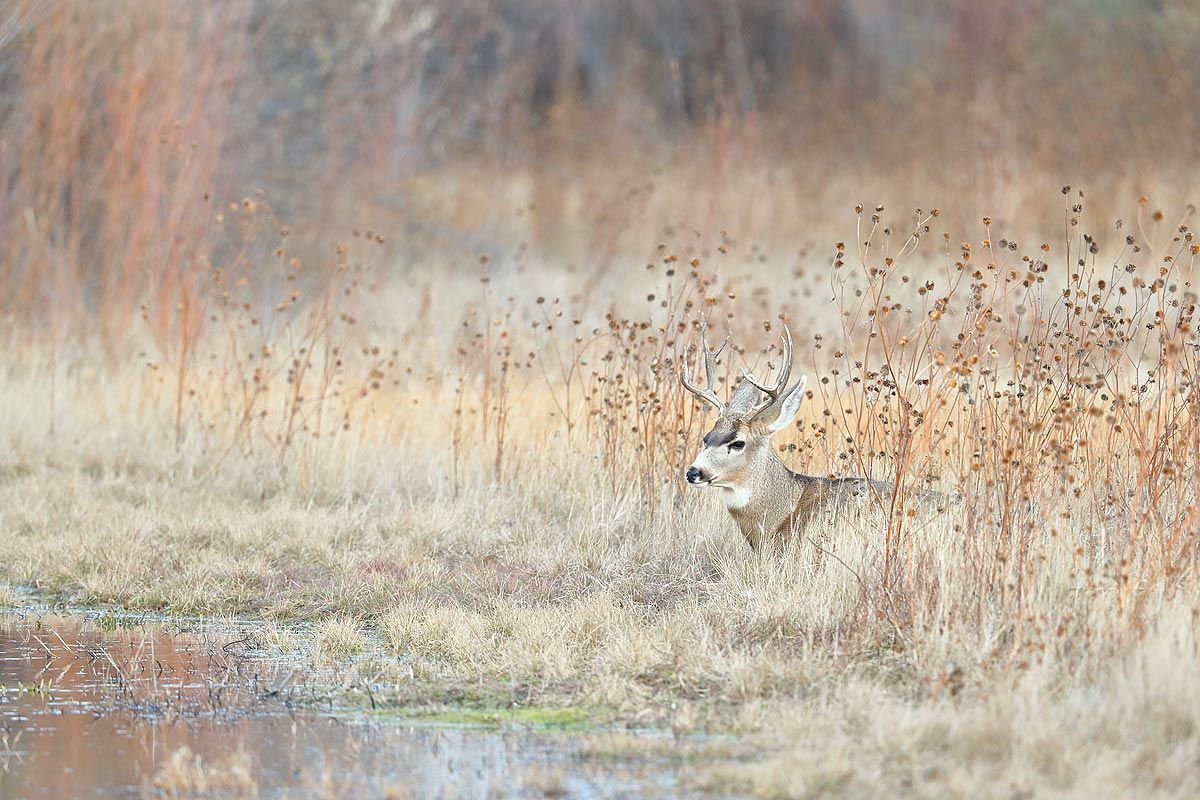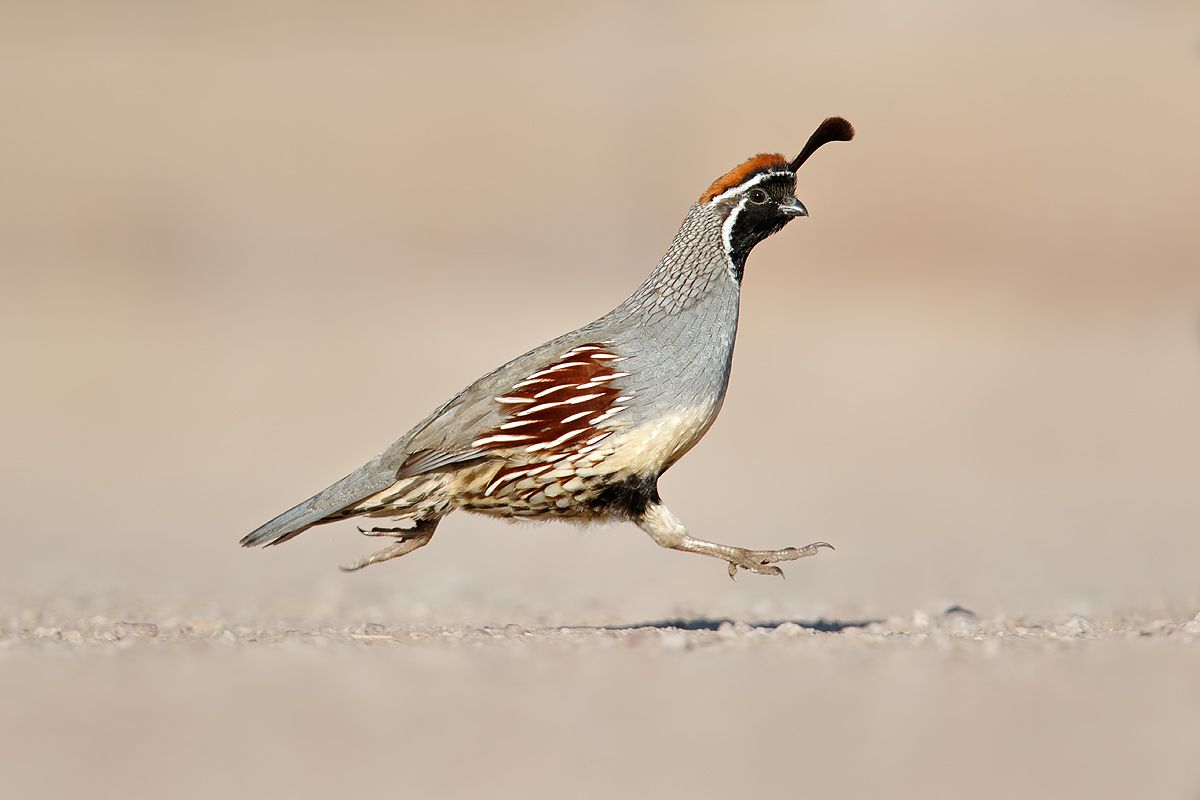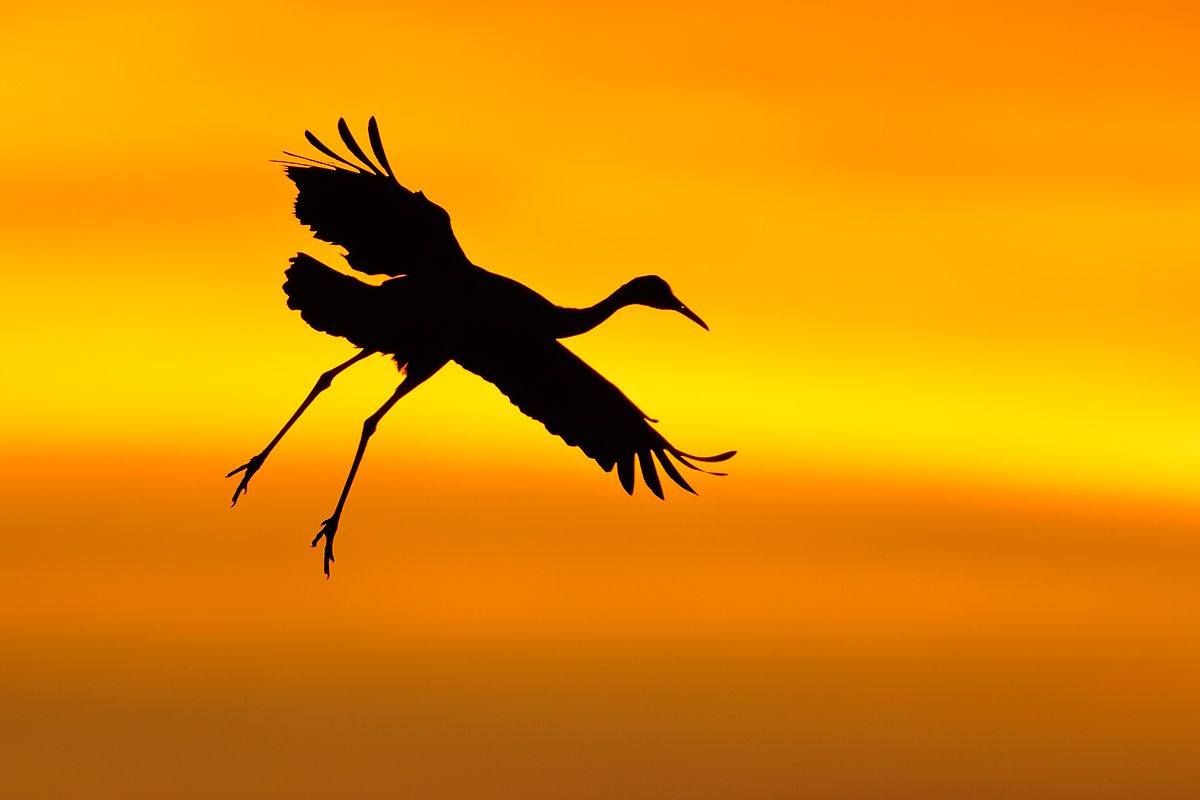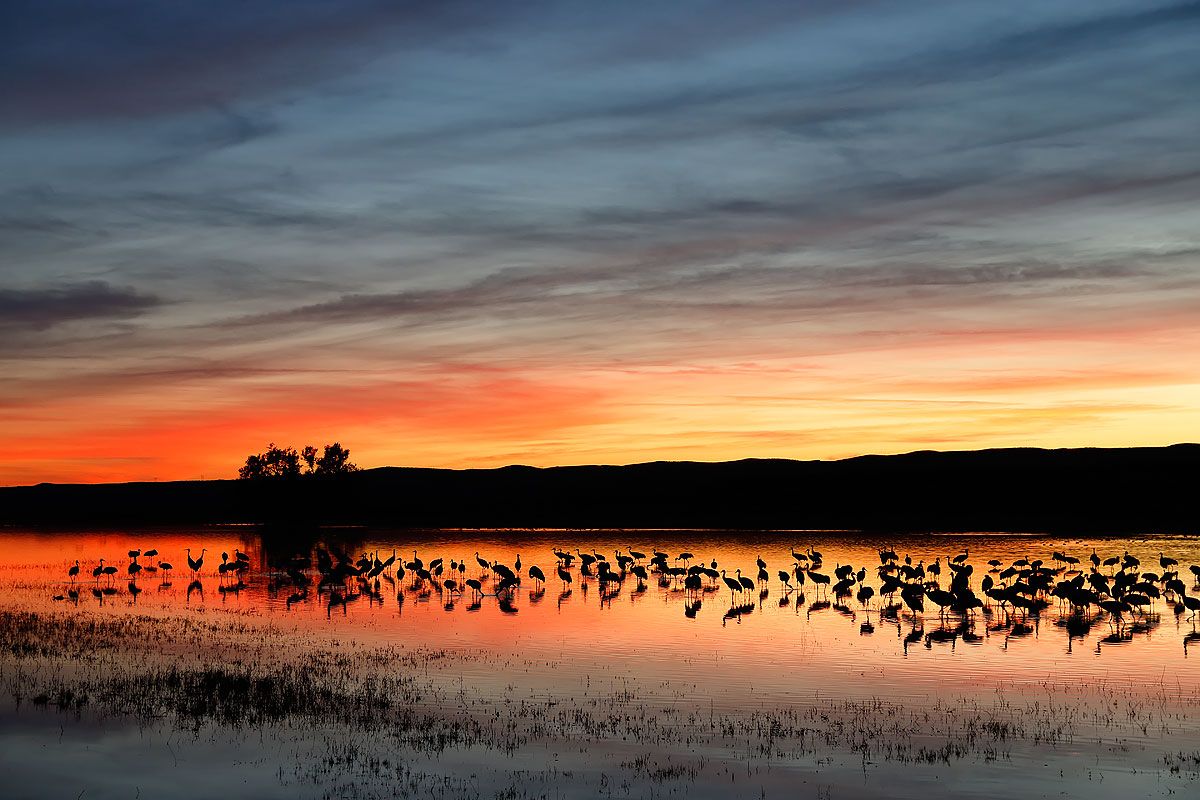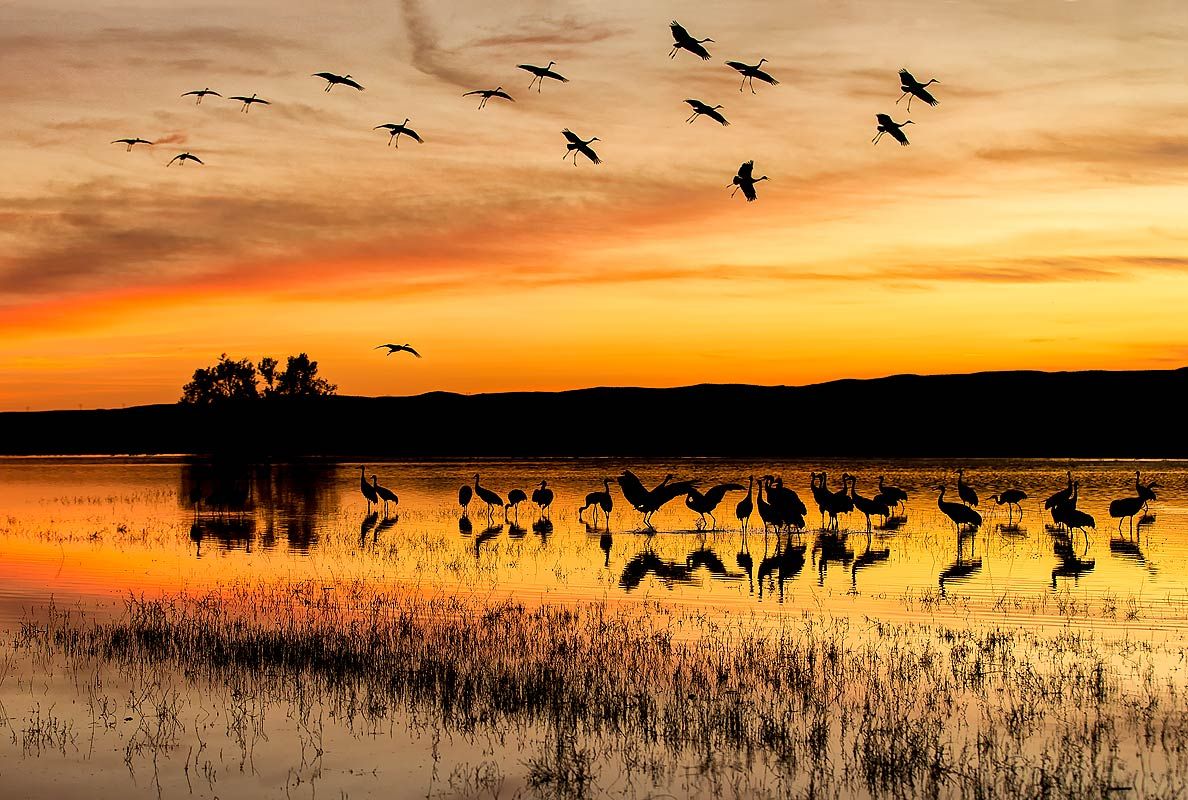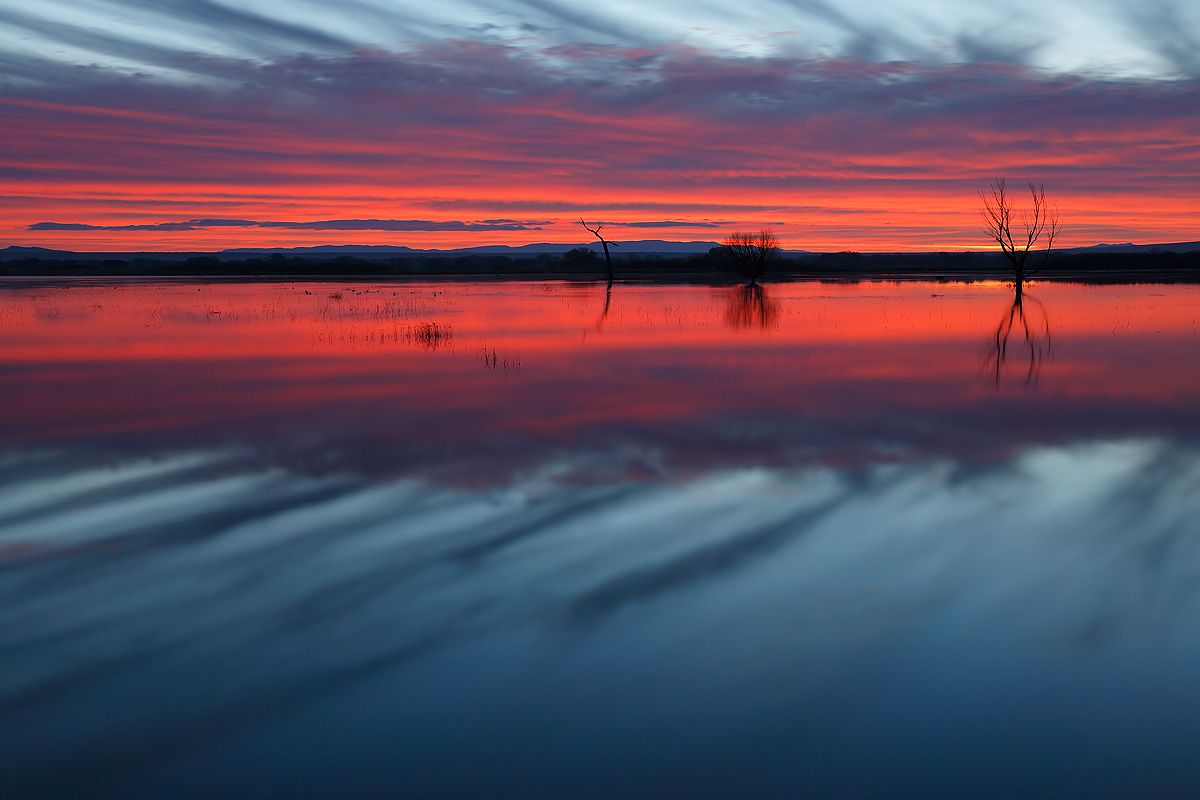It's been a while since I published my last blog post. A change in professional career prevented me from traveling to far away places this year as all the focus was on learning a new business. A business closer to the avian subjects I like to photograph. The medium shifted from water to air as my focus is on building a private aviation company. With the year coming to an end I needed a break and clear my mind. What better place is there than Bosque del Apache NWR in New Mexico. Every year large flocks of birds leave the arctic breeding grounds at the end of the summer and head down south to warmer climates to spend the winter. They are following the same path every year and end up in the same places most of the time, as if they were programmed to do so.
Bosque - A special place
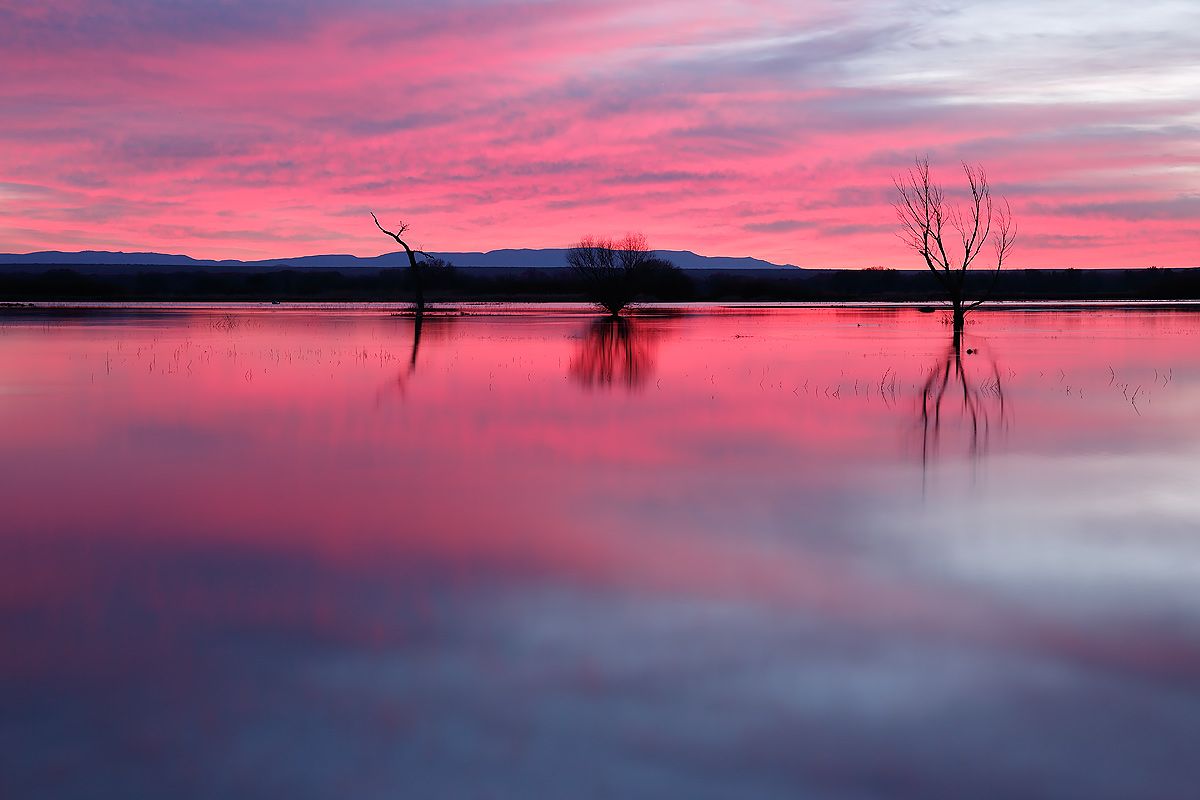
Pink sunrise on the main pond. Canon EOS 5D MkIII, Canon EF 24-70mm f/2.8L II USM Lens @ 65mm, f9, 8s, ISO 200, Manual exposure. Image by Clemens Vanderwerf and copyright 2014.
Snow geese flying at sunrise. Canon EOS 5D MkIII, Canon EF 24-70mm f/2.8L II USM Lens @ 70mm, f5, 1/200s, ISO 800, Manual exposure. Image by Clemens Vanderwerf and copyright 2014.
The wildlife refuge is located about 100 miles south of Albuquerque along the floodplain of the Rio Grande river, and got it's name from the Apaches who frequently camped in the riverside forest (bosque). It was establish in 1939 and is managed by the US Fish and Wildlife Service. The heart of the refuge comprises of irrigated farm and wetlands, and it extends into grasslands and the foothills of the Chupadera and San Pascual Mountains. It is a perfect place for many wintering birds species that are attracted to the wetlands and the food available in the farm fields. Large flocks of snow geese and sandhill cranes start arriving in early November and stay at the refuge until mid February before they start heading back north again.
Sandhill crane and setting full moon. Canon EOS 7D MkII, Canon EF 600mm f/4L II USM Lens @ 600mm, f7.1, 1/1000s, ISO 400, Manual exposure. Image by Clemens Vanderwerf and copyright 2014.
Bosque del Apache NWR is a popular place for bird photographers as it allows you to get relatively close to tens of thousands of geese, cranes and waterfowl. Bosque is also famous for its spectacular sunrises and sunsets with lots of color in the sky. Combine that with plenty of birds and you have the opportunity to make beautiful images. As with everything in wildlife photography, the circumstances are never the same and change often from one year to the next, or from one week to the following. During my visit in the second week of December there was no shortage of birds, but they where pretty far away as the farm fields where the birds usually feed were already depleted. The farm fields are accessible by a loop road through the refuge. Early in the season the farmers cut the corn and alfalfa crop close to the road making it easier to get close to the large groups of snow geese and sandhill cranes, which often perform spectacular blast-offs initiated by coyotes or raptors circling in the air. During the day the birds feed in the different fields and leave in the late afternoon to the wetlands and pools to spend the night. This migration within the refuge is a daily activity and creates good photographic opportunities.
Sandhill cranes flying in sync. Canon EOS 7D MkII, Canon EF 200-400mm f/4L USM Lens with Internal 1.4x Extender @ 377mm, f5.6, 1/2000s, ISO 400, Manual exposure. Image by Clemens Vanderwerf and copyright 2014.
I had a chance to meet with the refuge manager and ask him about the developments at the refuge. Last year and this year they had trouble finding farmers willing to farm the fields at the refuge. Without good farmers there is little chance to get good crops of corn to feed the birds. The refuge is actively seeking new farmers to work the fields, but there are certain restrictions that make it not very attractive for the commercially oriented farmers. It is not allowed to plant genetically modified corn, neither is the use of pesticides allowed. The refuge is afraid that run off water with pesticides will pollute the water at the refuge and will harm the migrating birds. Although the farmers do not have to pay anything for the use of the land at the refuge, the restrictions make it not so easy to find the right farmers, yet the refuge manager was confident that next year the corn crop will be back at historic levels.
Orange sunset with sandhill cranes and snow geese. Canon EOS 1Dx, Canon EF 24-70mm f/2.8L II USM Lens @70mm, f10, 1/250s, ISO 800, Manual exposure. Image by Clemens Vanderwerf and copyright 2014.
It was also interesting to hear about the sequence of flooding the farm fields to create the wetlands for the waterfowl. The main pond at the entrance of the refuge used to be full with thousands of snow geese in the early mornings. At sunrise this was always the best spot to photograph the birds leaving the main pond in large flocks usually against a beautifully colored sky. During my visit the main pond was completely empty in both the morning and afternoon. The refuge manager explained that the main pond is always the first of the fields to get flooded with water from the Rio Grande because it takes quite a while to fill it up. The birds and waterfowl arriving early in the season frequent this pond a lot and deplete it from all the nutrients. Once it is depleted they move on to the other flooded fields at the refuge until those are depleted from nutrients as well. The refuge management keeps a close look at the status of the flooded fields and turns other fields into wetlands as the season progresses.
Sandhill crane flying out after sunrise. Canon EOS 7D MkII, Canon EF 600mm f/4L II USM Lens @ 600mm, f4, 1/640s, ISO 800, Manual exposure. Image by Clemens Vanderwerf and copyright 2014.
The constant flooding and drying of the fields keeps the nutrient levels up and simulates the flooding of the Rio Grande in the old days before people started building dams and irrigation ditches to manage the flow of the river and divert water for crops, livestock, and homes. The corn only provides the birds with a quick snack, or a "Snickers-bar" as the refuge manager called it. The real food source with high nutritional values is hidden in the mud of the flooded fields where the birds find the complete spectrum they need to strengthen for the migration back north.
Sandhill cranes with orange sunset clouds. Canon EOS 7D MkII, Canon EF 70-200mm f/2.8L II USM Lens @ 145mm, f5, 1/500s, ISO 400, Manual exposure. Image by Clemens Vanderwerf and copyright 2014.
The two flooded fields (crane pools) along Highway 1 just outside the refuge where very productive this year. Nearly all the sandhill cranes and lots of snow geese were spending the night here. Just before sunset the sandhill cranes and the geese start to arrive and pack together in large groups. After sunrise in the early morning the birds would fly off again on their way to the farm fields to feed for the day. The wind direction and the light angle play an important part on where you position yourself to get the best flight images without too much shadows on the birds.
Sandhill crane leaving the crane pool. Canon EOS 7D MkII, Canon EF 200-400mm f/4L USM Lens with Internal 1.4x Extender @ 448mm, f5.6, 1/2000s, ISO 400, Manual exposure. Image by Clemens Vanderwerf and copyright 2014.
Every now and then the cranes display courtship behavior and dance around each other for a short period. Ideally you want to be photographing down the light angle with as less distracting birds in the background as possible. With thousands of sandhill cranes in the pool that is no easy task, but after a while when many cranes leave it becomes easier to make nice compositions. The main trick is to keep moving and put yourself in the best position all the time in this very dynamic environment.
Sandhill crane dancing. Canon EOS 7D MkII, Canon EF 200-400mm f/4L USM Lens with Internal 1.4x Extender @ 533mm, f5.6, 1/1250s, ISO 400, Manual exposure. Image by Clemens Vanderwerf and copyright 2014.
Sandhill cranes displaying courtship behavior. Canon EOS 7D MkII, Canon EF 600mm f/4L II USM Lens @ 600mm, f6.3, 1/1250s, ISO 400, Manual exposure. Image by Clemens Vanderwerf and copyright 2014.
One thing I love about Bosque is the intense blast-offs of thousands of snow geese at the same time. The visual show and accompanying sounds are breathtaking and a great nature spectacle to watch. With the geese about half a mile away in the corn fields a long lens was needed to get some good compositions. For me the blast-off images only work with slow shutter speeds in the range between 1/8s and 1/30s. The painterly effect is much more pleasing than a sharp representation of thousands of birds flying off. In order to keep the subject visible in the image it is important to pan with the birds at exactly the same speed as the flying speed of the subjects. This will render some birds relatively sharp and you know what you are looking at.
Snow geese blast off in the corn field. Canon EOS 1Dx, Canon EF 600mm f/4L II USM Lens @ 600mm, f11, 1/15s, ISO 160, Manual exposure. Image by Clemens Vanderwerf and copyright 2014.
Snow geese blast off with Chupadera mountains in the background. Canon EOS 1Dx, Canon EF 600mm f/4L II USM Lens and 1.4x TC@ 840mm, f7.1, 1/15s, ISO 50, Manual exposure. Image by Clemens Vanderwerf and copyright 2014.
There is an iconic cottonwood tree at one of the crane pools. Before I left for New Mexico I was thinking what I could do with this tree that would be different and creative. Light painting is a technique that can be used to accentuate certain subjects in the dusk or dark. I had this image in my mind of a sky full of stars and the cottonwood tree popping out into the image. It would be really nice if a couple of sandhill cranes would stand in front of the tree as well. The tree on the other side of the pool was about 200 yards from where I would set up my camera. I bought a 500 lumens flash light at Walmart to have enough power and reach with the light beam to reach the tree. To avoid getting star trails the maximum exposure would be about 15 seconds, but I needed the time to paint the tree and the foreground. I discovered that you have to move around the light beam a lot to prevent it from showing up in the image. It kept me going for a while and it was a lot of fun.
Cottonwood tree with stars. Canon EOS 5D MkIII, Canon EF 70-200mm f/2.8L II USM Lens @ 70mm, f2.8, 15s, ISO 400, Manual exposure. Image by Clemens Vanderwerf and copyright 2014.
Small cottonwood tree with sandhill cranes at dusk. Canon EOS 1Dx, Canon EF 70-200mm f/2.8L II USM Lens @ 95mm, f4, 10s, ISO 800, Manual exposure. Image by Clemens Vanderwerf and copyright 2014.
The red-winged blackbirds are a lot of fun to watch as they move gracefully in large flocks across the corn fields flashing their red and yellow wing patches when they change direction. I had seen them nearly every day but they were too far away to take any decent images. My luck was running out and the chance of going back home without any blackbird images seemed high, until the last afternoon in the field. I got a private show for about half an hour right in front of me, and took about 500 images with various shutter speeds from 1/4s to 1/3200s, all the while trying to pan with the speed of the flock which made constant abrupt movements. I only liked a couple of images.
Red-winged blackbirds moving through the corn fields. Canon EOS 1Dx, Canon EF 600mm f/4L II USM Lens with 1.4x TC @ 840mm, f5.6, 1/2500s, ISO 1250, 3-stop Neutral Density Drop-in Filter, Manual exposure.
Ross's Goose. Canon EOS 7D MkII, Canon EF 600mm f/4L II USM Lens @ 600mm, f5, 1/1600s, ISO 400, Manual exposure. Image by Clemens Vanderwerf and copyright 2014.
Although the snow geese and the sandhill cranes are the most common birds in Bosque, there is a wide variety of other birds species, such as the Ross's goose with a shorter bill than the snow goose, and a large amount of different ducks. Raptors are also plentiful with hawks, bald eagles and american kestrels looking for prey. I even spotted a bobcat crossing the loop road, and some hogs in the corn fields but these shy animals are hard to photograph. Along the marsh loop road on the south side of the refuge is usually not a lot of activity going on due to lack of corn fields in that area, but I spotted a group of mule deer resting near the edge of a flooded field.
Mule deer buck at the edge of water. Canon EOS 1Dx, Canon EF 600mm f/4L II USM Lens and 1.4x TC @ 840mm, f5.5, 1/160s, ISO 2000, Manual exposure. Image by Clemens Vanderwerf and copyright 2014.
Gambel's Quail running. Canon EOS 7D MkII, Canon EF 600mm f/4L II USM Lens and 1.4x TC @ 840mm, f5.6, 1/2000s, ISO 400, Manual exposure. Image by Clemens Vanderwerf and copyright 2014.
The best part of Bosque del Apache are the colors. The warm tones of the adobe mountains as backdrop for flying birds or the spectacular sunrise and sunset colors with tones of yellow, pink, red and orange are one of the best I have ever seen. They make your images literally so much more colorful.
Sandhill crane silhouette at sunset. Canon EOS 7D MkII, Canon EF 600mm f/4L II USM Lens and 1.4x TC @ 840mm, f5.6, 1/1250s, ISO 400, Manual exposure. Image by Clemens Vanderwerf and copyright 2014.
Sandhill cranes roosting for the night. Canon EOS 5D MkIII, Canon EF 24-70mm f/2.8L II USM Lens @ 70mm, f5.6, 1/60s, ISO 800, Manual exposure. Image by Clemens Vanderwerf and copyright 2014.
Sandhill cranes flying in for the night. Canon EOS 1Dx, Canon EF 24-70mm f/2.8L II USM Lens @ 70mm, f3.5, 1/320s, ISO 800, Manual exposure. Image by Clemens Vanderwerf and copyright 2014.
Predawn colors at the main pond. Canon EOS 5D MkIII, Canon EF 24-70mm f/2.8L II USM Lens @ 39mm, f14, 10s, ISO 400, Manual exposure. Image by Clemens Vanderwerf and copyright 2014
Bosque del Apache NWR is a special place that will always draw me back for more. It was nice to break out for a week and hang out with friends and create some nice images at the same time. Although the week around Thanksgiving is the most visited week during the season due to the Festival of the Cranes, any other week will yield as many good photo opportunities as well. I will be back in 2015.
The complete portfolio of my trip to Bosque can be viewed on my website at www.clemensvanderwerf.com

